By Mark van der Feyst
Photos by author except where noted
The majority of homes in North America have a garage of some type associated with it. Garages have become a standard feature of many homes, and firefighters need to be aware of the potential hazards these compartments/structures may contain. A garage by definition is a shelter or repair shop for automotive vehicles. That definition has changed over the years to not only include automobile storage or repairs but also as an extra space for storing household items, as a converted office, and as a man cave. The modern day garage was born out of the old carriage houses used to store the horse and carriage back when that was the only mode of transportation. As the automobile was introduced and grew in popularity, the garage became the house for the “modern horse and carriage.”
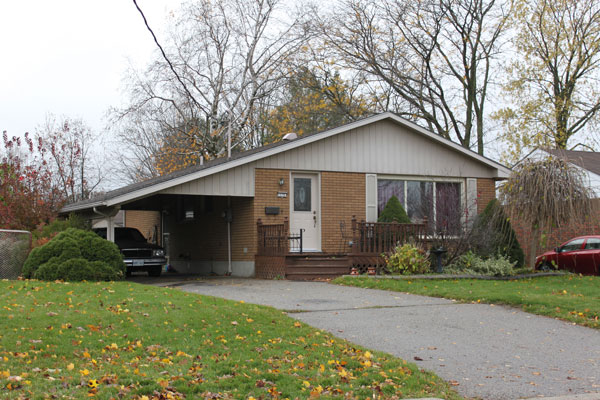
(1)
Types of Garages
There are many types of garages, depending on the type of house, the lay of the land, and the needs of the homeowner. In one-story houses such as ranches or bungalows, the garage will be at one end or the other if it is attached to the house. Some one-story homes have the garage separated from the house; it will be behind the home, beside the home, or in front of the home. Certain houses built in the 1960s and the 1970s had a carport attached to the home (photo 1). It served as a half garage; it had only a roof covering over the vehicle. Some carports have been converted into a fully enclosed garage over the years; others were given a facelift.
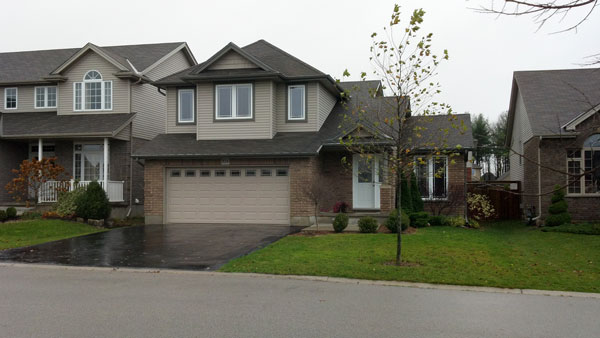
(2)
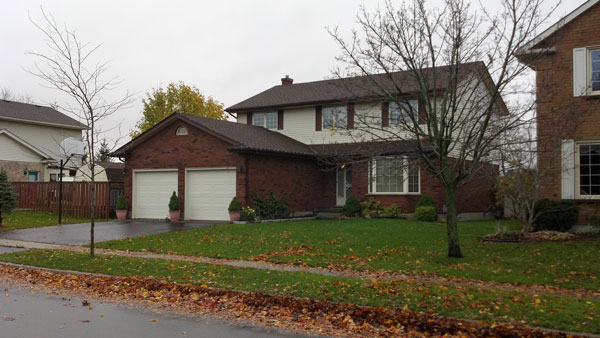
(3)

(4)
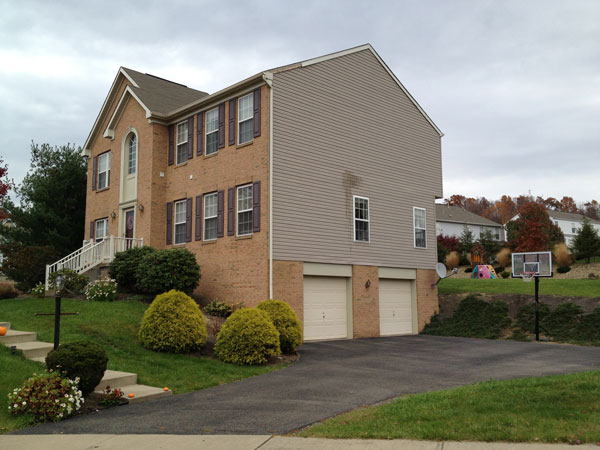
(5) Photo by Timothy Llewellyn.
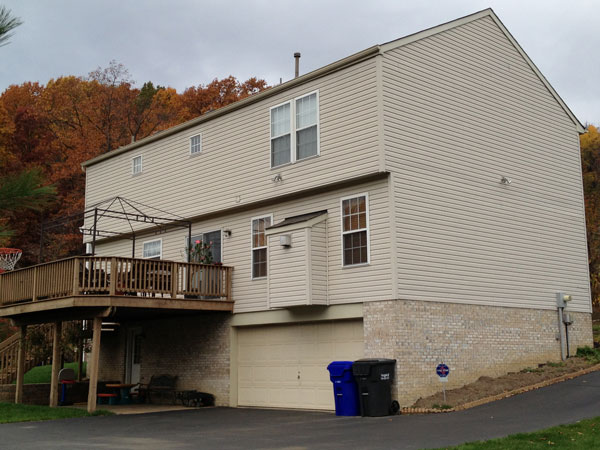
(6) Photo by Timothy Llewellyn.
In a two-story home, the attached garage can be in a few different locations. It is sometimes in the front of the house with the second story built above it (photo 2), or it is extended from the house with the roofline from the second story, which continues with it (photo 3). It can also be located on the side of the house and can be accessed only from the side only (photo 4). The front of the house façade continues along the one garage wall to make it appear as a part of the home. These types of garages can have the house’s second story over top of the garage or just the roof line continuing on with it.
Another location for the garage is on one side of the house, but below grade as part of the basement. These types of garages can be found in both single- and two-story homes. The garage can be accessed from either the side of the house or from the back of the home (photo 5). Having the access from the back hides the garage from the street view and gives the home a certain look (photo 6). A majority of homes in developments are built with the garage as part of the basement. Knowing the developments in your response area will help you to identify the locations of the garages.
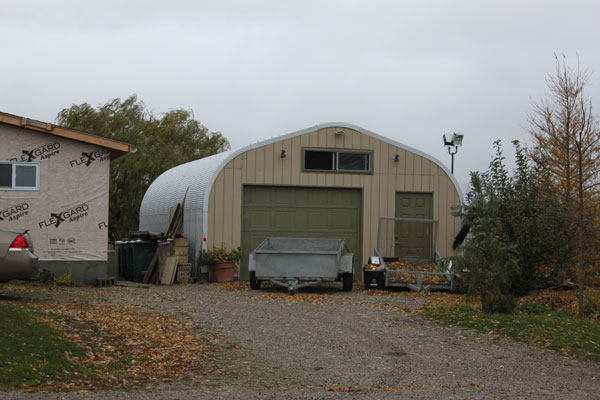
(7)
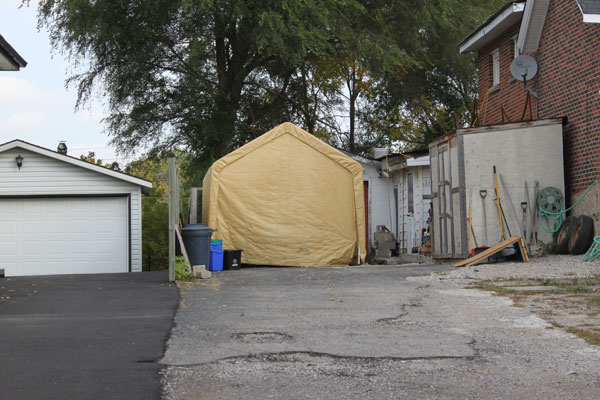
(8)
Some homeowners prefer to have a detached garage either in addition to the attached garage with the house already or as a stand-alone structure for the home’s main garage. Many styles of detached garages can be built either using a kit purchased from the local building center or custom built by a contractor. Depending on cost, a detached garage can be constructed of wood or metal. Garage kits that can be constructed by the homeowner are becoming popular because they are relatively cheap to build and quick to put up. The steel garage kit is an example of this (photo 7). These garages can also be taken apart and taken with the homeowners when they move. Some homeowners use temporary tent garages to house their vehicles or to store other items (photo 8). These tents can be set up in front of, beside, behind of the house–wherever residents want it. Sometimes they are set up in front of the house garage as a way to extend the garage for certain reasons.
The inside finish of the garage can vary; it can be finished or left unfinished. Depending on the garage location, the ceiling area and/or the wall dividing the living area from the garage will be finished only as part of the building code requirements. The finish will consist of 5/8-inch fire rated drywall with at least two coats of plaster applied on the seams. This is to prevent any carbon monoxide gases from entering the house as well as to decrease fire spread from the garage area into the living areas.
Fire Growth Danger
Fires in garages are not just dangerous because of their contents but also because of its location in relation to the residential structure. The lower the garage relative to the structure, the more quickly the fire will spread to the entire structure and the more dangerous it will be for occupants above or inside the structure. Houses that have the garage below grade with access either from the side or from the back face this dilemma. With a good concentration of fuel load in the garage as well as above the garage with household furnishings and contents, the fire spread will be greatly affected by the upward ascent of heat and flame
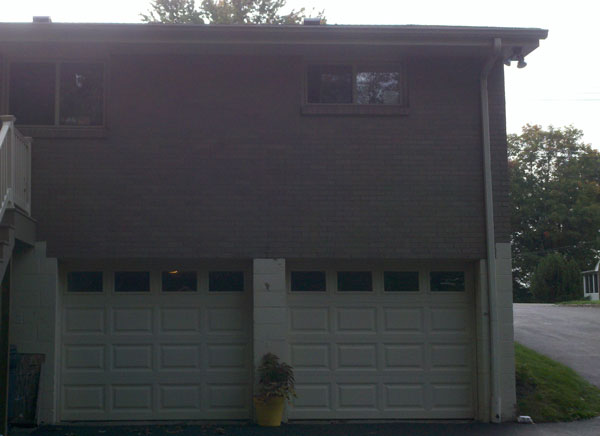
(9) Photo by Eric Wissner
Another aspect of quick fire spread within the garage is the height of the garage. Garages below the house will have low head room within the garage. The height of the basement dictates the height of the garage. Typically, the average height of a basement is about eight feet; the basement height in some older homes is seven feet in height. This smaller space allows fire to develop and spread a lot more quickly compared to a garage built in the front of the house with a much higher ceiling height. Along with the faster fire development and spread, the chances for occupants becoming trapped within their bedrooms increase. Many bedrooms are above or beside (on the second floor) the garage. The secondary means of escape can be cut off by autoexposure of flame at the bedroom windows. In photo 9, you can see two bedroom windows above the garage that are part of the basement.
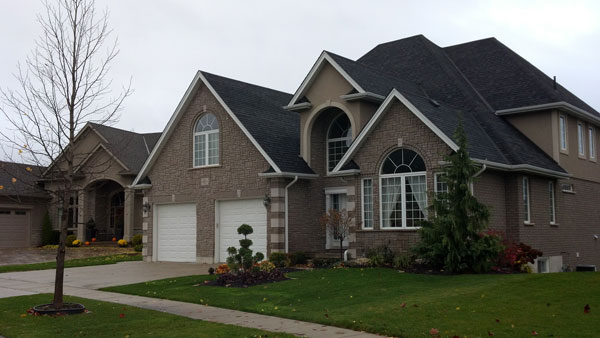
(10)
Construction properties of garages also play a role in the growth of fire and how quickly it can spread or fail. The use of lightweight building materials has become standard in the construction industry. Depending on the design of the residential structure, certain lightweight trusses or laminated I-beams can be used to obtain larger spans for the garage. If the garage has a living space above it, such as a bedroom or a great room, the span needed to obtain that living space is going to require the use of a lightweight building material. Even though there is a fire separation between the two areas (if built to code and inspected), there is still a danger of potential failure of the truss members. In an unfinished garage, having the web joist of the truss exposed will greatly increase the failure of the member. Photo 10 shows a garage with a living space above it built with lightweight truss construction.
Fire stopping is installed between the residence and the garage area as a way to slow down and prevent fire spread. This only works when the fire stopping has not been compromised and is complete. Whenever home renovations occur, holes are created as a way to access other areas for wiring, HVAC, and plumbing purposes. When these holes are not patched back up and are left open, there is no more fire stopping. The fire can easily spread from the garage into the rest of the residence through the hole(s). Unfortunately, there are no inspections taking place after the house has been built and occupied to ensure that the fire stopping originally installed is still intact. We are relying on the homeowner to be responsible.
Dangers Inside and Outside the Garage
Inside any garage is a world of unknowns as far as the content is concerned. This would be similar to a transport vehicle bearing the “Dangerous” placard–many unknowns on the inside. Certainly, a vehicle would be the logical and expected choice, but this is not always the case. As mentioned previously, garages have become more than just a vehicle storage place. They have become a storage facility for the homeowner, or they have become a converted office space or a workshop or a den. Regardless of what the use is, some hidden dangers are lurking inside, waiting for firefighters.
On the outside, certain garage models may have solar panels on the roof. These panels may be used for electricity generation or to heat pool water in the summer. The added weight of the solar panels along with the lightweight construction used to construct the garage will provide an unsafe work environment and offer a failure potential.
Outside, around the garage can be unknown hazards that result from improper housecleaning. Rubbish or junk may be mixed in with propane cylinders, fuel cans, flammable liquids, tires; tires and other junk items may be piled around the outside of the garage. Heavy items piled against the walls of the garage also present a hazard. Depending on how high the object is, there is the possibility of its falling over and hitting a firefighter or pushing against the garage wall which may have been weakened by the fire and heat, thus leading to the wall’s collapsing.

(11) Photo courtesy of Garage Strategies (http://www.garagestrategies.com/four_post_lift.html)
The majority of the hidden dangers are inside the garage. Vehicles parked inside will present a large fire load–gasoline or diesel, oils, plastics, rubber, and other automotive fluids. Depending on the size and type of garage, one, two, or multiple vehicles may be parked inside. Some homeowners will store their vehicles inside their garage during the winter months or create more space within their garage by using a four-post car lift (photo 11). This product allows a homeowner to store the vehicle off the ground to create more storage space or to park another vehicle below it. The car lift can be freestanding or bolted down to the garage floor and operated with a cable lift system. Having a vehicle suspended above the garage floor with fire on the inside of the garage presents a significant hazard to firefighting crews. The cables used to hoist, the safety pins, and even the vertical stands could fail if exposed to high heat and the weight.
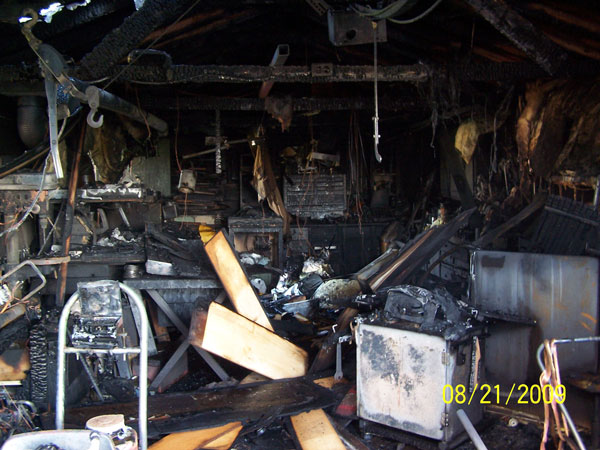
(12)
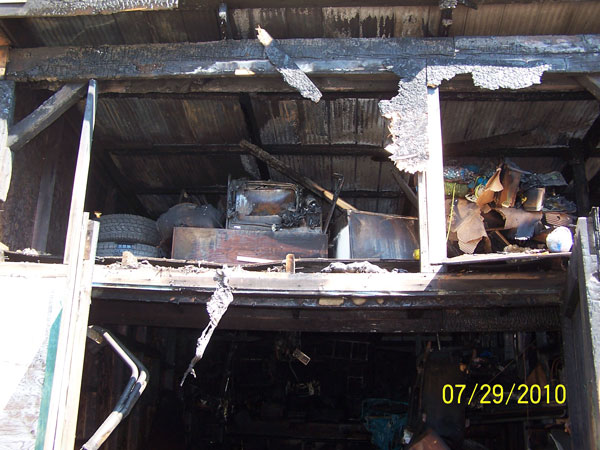
(13)
Another area of concern is the attic space above the garage, which is often also used for storage. Depending on the type of finish within the garage and whether the ceiling is open or sealed, the area will be either hidden or open to observation. A hidden storage area will have an access door with an extendable ladder attached to it somewhere in the ceiling that can be pulled down. If the ceiling area of the garage is open, then the access to that area can be from anywhere. The hidden danger here is the number and type of items stored above. Heavy loads can be stored up above the garage resting on the truss chord for support. In photo 12, this garage had piles of pine board stored above. Two piles were about two feet in height and about four feet wide. The truss chord failed during the fire, allowing that heavy load to fall. In photo 13, you can see remaining items that are still aloft in the storage area, which contain tires, television, furniture, and numerous other household items.
Products stored in a garage can vary in type, size, and quantity. A garage may contain cleaning products, fuels stored in cans or plastic containers, propane cylinders, ammunition, chemicals used for lawn control and pools, and paints. This list is generic, as there can be many other products in many forms within the garage. Mixed in may also be equipment such as welding machinery. Welders come in different forms such as arc, oxyacetylene, Mig, and Tig. All of them with the exception of the arc welder will have a gas cylinder attached, presenting a potential boiling-liquid-expanding vapor explosion. An oxyacetylene welder has both oxygen and acetylene cylinders. Both of these gases are dangerous to firefighters; one is an oxidizer, and the other is very unstable.

(14)
As mentioned earlier on, some garages are used for storage. The stored items can present a hazard for the responding fire department. Heavily congested garages are as dangerous as houses occupied by a hoarder (see photo 14). The congestion will prevent access into the garage or the house if a man door is present. An occupant trying to escape from the house through the garage will have a difficult time, and so would firefighters if they had to leave the structure the same way. The contents may also present as high-pile storage, depending on the height of the garage and the piles of stuff stored; there is the potential for piles falling over and on top of firefighters.
Some garages have utilities servicing them such as electricity, natural gas, or propane. An electrical panel, hot water heaters, and gas unit heaters may be inside the garage. Turn off these utilities; they will contribute to the hidden dangers waiting inside. If the electrical power is run from the house, you will need to deal with the main panel inside the home. Look for a propane tank that may be situated near the wall on the outside. Gas unit heaters hanging from the ceiling are overhead hazards as well as models that have long horizontal runs for radiant heat.
One of the biggest dangers is the garage door. Whenever interior operations are warranted, the garage door needs to be isolated so that it will not fall back down or close, trapping firefighters inside. If it is a manual garage door, use a pair of vise grips and clamp the track at the point where the garage door is open to prevent the door from closing. Using a pike pole or a roof hook will also work, but there is the chance that it may be kicked out and allow the door to close. Assigning a firefighter to manually hold the door open using a pike pole or a roof hook may be the better choice. The firefighter should be in a kneeling position to remain out of the travel path of heat and smoke. If an automatic door opener attached, institute the same provisions, as the latch pin securing the door to the door opener may fail or come loose, allowing the door to close. The emergency pull chord may also be pulled accidentally. To prevent the door from closing automatically, disconnect the door from the system and prop it open.
The next time there is a call for a garage fire, do not approach it as just another garage–hidden dangers are going to be present. When you are driving around your response area, observe the types of garages, their locations in relation to the houses, and items that are piled around the garage. This is a great topic and an easy training session, and it will improve size-up skills.
MARK VAN DER FEYST is a 14-year veteran of the fire service and a member of the Woodstock (Ontario, Canada) Fire Department. He is an international instructor teaching in Canada, the United States, and India; a local level suppression instructor for the Pennsylvania State Fire Academy; and an instructor for the Justice Institute of British Columbia.

